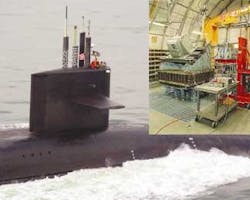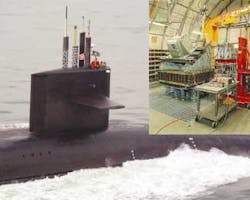Carlo Gavazzi Mupac produces Navy's new submarine communication receivers
By John McHale
BROCKTON, Mass. — Engineers at Carlo Gavazzi Mupac in Brockton, Mass., have designed a new submarine low-frequency/very low-frequency VMEbus receiver chassis for the U.S. Navy Space and Naval Warfare Systems Center (SPAWAR) in San Diego.
The designers built the receiver, better known as the SLVR, from commercial off-the-shelf (COTS) components and ruggedized the receiver to withstand the rigors of military undersea operations.
The SLVR will be installed on all three classes of U.S. submarines — the Los Angeles–class (SSN 688), Seawolf-class (SSN 21) fast-attack submarines, and the Ohio-class (SSBN 726) ballistic-missile submarines — as well as associated tender and shore installations, says Ted Brewster, senior vice president of sales at Carlo Gavazzi.
SLVR is one of the most important pieces of equipment aboard U.S. strategic ballistic missile submarines because it receives crucial strategic communications from national command authorities on when — or when not — to initiate global thermonuclear war. SLVR is already a key factor in the nine-rack radio room for the Navy's nuclear fast attack submarines, Carlo Gavazzi officials say.
The SLVR was made famous in the movie "Crimson Tide," starring Denzel Washington and Gene Hackman, when it failed to receive the Emergency Action Message instructing the submarine captain whether or not to fire his nuclear arsenal in response to a Russian attack.
"The Carlo Gavazzi team was challenged to redesign the existing VXI chassis to meet the MIL- S-901D near-miss shock requirement for the SLVR program" under an aggressive schedule and a difficult shock test program, and still passed all necessary shock test requirements, says Rear Adm. John Gauss at SPAWAR.
The aggressive scheduling came as a result of Navy officials changing some shock and vibration requirements at the last minute; Carlo Gavazzi engineers had to scramble to meet the new regulations and did so successfully, Brewster says.
The SLVR design uses an open-system architecture based on VME and VXI COTS printed circuit boards, which reduces system development time and cost, Carlo Gavazzi officials say. It uses a militarized chassis design from Carlo Gavazzi to protect internal COTS components.
The SLVR, which uses the military nomenclature AN/WRR-7B, replaces four systems in the AN/WRR-12, which is based on 1970s technology, Brewster adds. A unique part of the design involves the different cooling approaches for each class of submarine — front to back, side to back, and side to side — Brewster explains.
A VME COTS design and industry-standard interfaces provide the Navy with a smaller system than the existing SLVR, with reduced power requirements that reuses existing software, Carlo Gavazzi officials say. The new SLVR system provides expandability options and twice the capability of its predecessor in the same space, they say.
The SLVR's R1739 receiver processor and demodulator uses 11 VXI cards from Hewlett-Packard Co. in Palo Alto, Calif., and 16 VME cards from Motorola Computer Group in Tempe, Ariz. The KG38 crypto device uses a secret National Security Agency–qualified board, Brewster says.
The Motorola board is "one rugged commercial device that survived a 100 Gs of shock testing," Brewster says. The shock and vibration testing was performed at the SPAWAR Environmental Test Laboratory in San Diego.
The SLVR chassis are also designed to meet many other military standards for vibration, operating temperatures, relative humidity, altitude, fungus, ship motion with as much as 60 percent incline, electromagnetic compatibility, DC magnetic fields, airborne/structure-borne noise, thermal requirements, and mean-time-between-failure/mean-time-to-repair requirements.
For more information on Carlo Gavazzi Mupac contact the company online at www.carlogavazzi.com.

